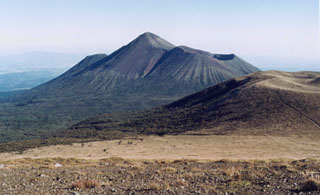Report on Kirishimayama (Japan) — 26 March-1 April 2025
Smithsonian Institution / US Geological Survey
Weekly Volcanic Activity Report, 26 March-1 April 2025
Managing Editor: Sally Sennert.
Please cite this report as:
Global Volcanism Program, 2025. Report on Kirishimayama (Japan) (Sennert, S, ed.). Weekly Volcanic Activity Report, 26 March-1 April 2025. Smithsonian Institution and US Geological Survey.
Kirishimayama
Japan
31.934°N, 130.862°E; summit elev. 1700 m
All times are local (unless otherwise noted)
The Japan Meteorological Agency (JMA) reported increasing unrest at Shinmoedake (Shinmoe peak, a stratovolcano of the Kirishimayama volcano group). The number of earthquakes with epicenters beneath Shinmoedake began increasing on 28 March. At around 0250 on 30 March a tiltmeter recorded 0.1 microradians of inflation. A volcanic tremor signal was detected at 0256 and lasted 10 minutes. At 0353 the Alert Level was raised to 3 (on a 5-level scale) and the public was warned to exercise caution within 4 km from Shinmoedake Crater. The number of earthquakes subsequently decreased after the inflation was detected. A field team that was deployed to the volcano observed nothing indicating increased activity. On 2 April the warning zone was reduced to 3 km.
Geological Summary. Kirishimayama is a large group of more than 20 Quaternary volcanoes located north of Kagoshima Bay. The late-Pleistocene to Holocene dominantly andesitic group consists of stratovolcanoes, pyroclastic cones, maars, and underlying shield volcanoes located over an area of 20 x 30 km. The larger stratovolcanoes are scattered throughout the field, with the centrally located Karakunidake being the highest. Onamiike and Miike, the two largest maars, are located SW of Karakunidake and at its far eastern end, respectively. Holocene eruptions have been concentrated along an E-W line of vents from Miike to Ohachi, and at Shinmoedake to the NE. Frequent small-to-moderate explosive eruptions have been recorded since the 8th century.

